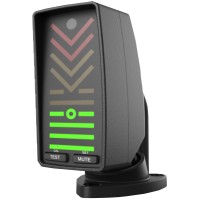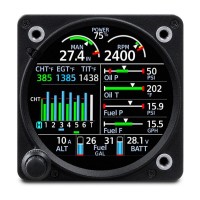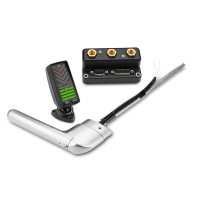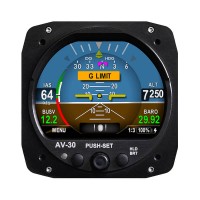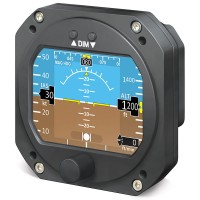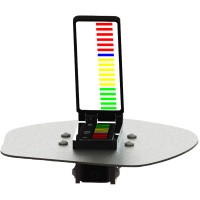1-877-795-2278 | info@aircraftspruce.ca
Aircraft Spruce Canada
Brantford, ON Canada
Corona, CA | Peachtree City, GA
Chicago, IL | Wasilla, AK
Aircraft Spruce Canada
Brantford, ON Canada
Corona, CA | Peachtree City, GA
Chicago, IL | Wasilla, AK
FREE SHIPPING ON ORDERS OVER $699 (SOME EXCLUSIONS APPLY) | 877-795-2278
AOA Falcon Above Dash Flush Mount Kit With HUD
Select Model:
Non PressurizedPressurizedSelect Type:
StandardDualOverview
|
The Falcon kit has a vertical light bar style display. With the vertical light bar display, when you come in for a landing you want to fly to the blue LED (on speed for landing). Should you come in with too low of an angle of attack, the display will illuminate into the yellow, telling you to put your nose up. Should you come in with too high of an angle of attack, the display will illuminate red, telling you to put your nose down. This kit comes with the Switch Panel Pre-Mounted in the Above Dash HUD (Heads Up Display) adapter kit.
The HUD is a self contained adjustable beam splitter adapter that mounts to the lip of the Falcon display and turns the Alpha System AOA into a true HUD. Intended for placement directly within the pilot's peripheral vision. Allows for instantaneous viewing of AOA information exactly where needed. The HUD glass is an enhanced color correcting, anti-glare lens. Comes complete with mounting frame, base adaptor plate, dome, display brackets and hardware. |
Features
- Instantaneous Angle of Attack indication.
- Three point calibration process, programmed on remote switch panel, to aircraft specific lift curve.
- 16 different LED brightness levels from ultra dim to very bright.
- Display has an imbedded photocell for daytime/nighttime brightness settings, choice of which is programmed at the display.
- Audio output, tied to existing audio input on audio panel by others.
- 4 different audio options to choose from which is programmed by the end user at the remote switch panel.
- Audio mute switch with amber LED indicator located on remote switch panel.
- 12-28 VDC input draws less than 0.250 Amps at full brightness.
Specifications
| Complete Kit Weight | Less than 3.00 lbs. | |
|---|---|---|
| AOA Interface Module size | In Inches: 5.75 x 2.60 x 1.65 | |
| System Voltage Requirements | 12 - 28 Volts DC | |
| System Max Power Draw | 0.250 Amps | |
| System Power Cable | 6 ft, three wires: power, ground and shield | |
| Above Dash HUD Weight | 4.32 oz / 0.270 lbs | |
| HUD Frame Dimensions | L: 4 1/8" x W: 1.250" | |
| HUD Base Adaptor Plate Dimensions | L: 4.613", W: 2.780" | |
| HUD Dome Dimensions | L: 4.251", W: 2.407", H: .960" | |
| Heated Probe Voltage Requirements | 12 or 24 VDC (must specify when ordering) | |
| Heated Probe Power Draw | 86 Watts at 12VDC / 172 Watts at 24VDC | |
| Heated Probe Current Draw | 8 Amps at 12VDC and 8 Amps at 24VDC | |
| Heated Probe Power Wire | Supplied by others | |
| Audio Output | 1 Volt P-P max at 300 ohm input impedance | |
| Aux (Audio) Cable | 6 ft, three wires: AP audio, AP ground and shield | |
| Audio Options | Four | |
| Mute Switch | Yes, on switch panel. | |
| LED Brightness Levels | 16, from ultra dim to very bright | |
| Photocell Diode | On display, allows for custom daytime/nighttime brightness settings | |
| Pressurized Version | Yes | |
Documents
- Falcon Installation Manual
- Falcon Operations Manual
- Quick Calibration Guide for Falcon Display
- Quick Calibration Failures for Falcon Display
- Falcon Pressurized Connection
- Falcon Display Dimensions
- Falcon Increasing AOA to Display Indications
- Falcon Segments Display Option
- HUD Heads Up Kit Dimensions
- HUD Base Adaptor Plate
In The Box
- Falcon Display (2 for Dual)
- Switch Panel Module
- I/F Module (2 for Dual)
- Non Heated Standard Probe
- 9x9 Probe Mounting Plate
- Above Dash HUD (Heads Up Display Adapter) (2 for Dual)
- Above Dash HUD Cover (2 for Dual)
- 6ft Power Cable
- 6ft Display Extension Cable (2 for Dual)
- 6ft AUX Cable
- 6ft Switch Panel Extension Cable
- 25 ft Blue Pneumatic Hose
- 25 ft White Pneumatic Hose
- Falcon Installation Manual
- Falcon Operations Manual
- Protractor
- Probe Cover
- Screwdriver
- Mounting Frame
- Base Adaptor Plate
- Dome
- Tinted Lens
- Custom Display Brackets
- Hardware
- HUD Cover with Flag
Q&A
Please note, Aircraft Spruce Canada's personnel are not certified aircraft mechanics and can only provide general support and ideas, which should not be relied upon or implemented in lieu of consulting an A&P or other qualified technician. Aircraft Spruce Canada assumes no responsibility or liability for any issue or problem which may arise from any repair, modification or other work done from this knowledge base. Any product eligibility information provided here is based on general application guides and we recommend always referring to your specific aircraft parts manual, the parts manufacturer or consulting with a qualified mechanic.

 Aircraft Spruce Canada
Aircraft Spruce Canada














